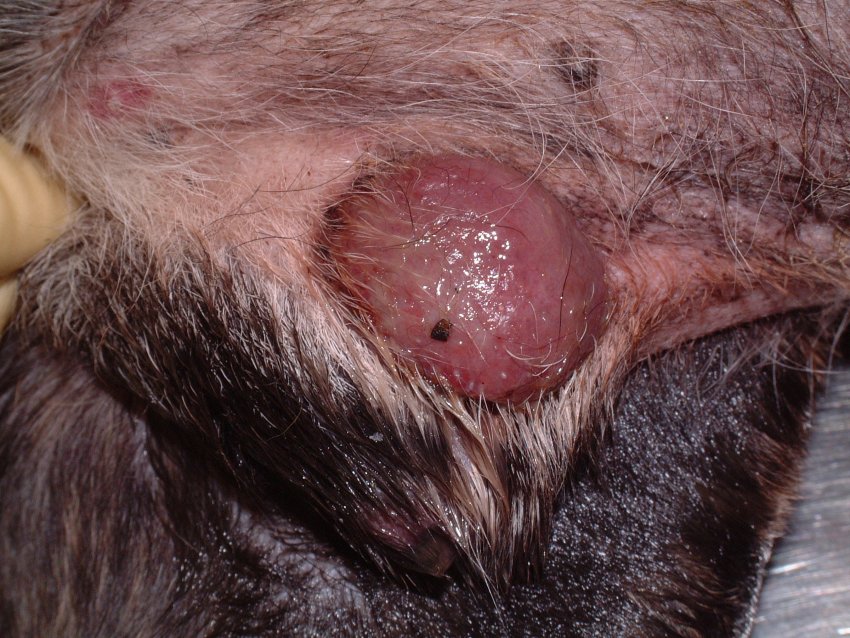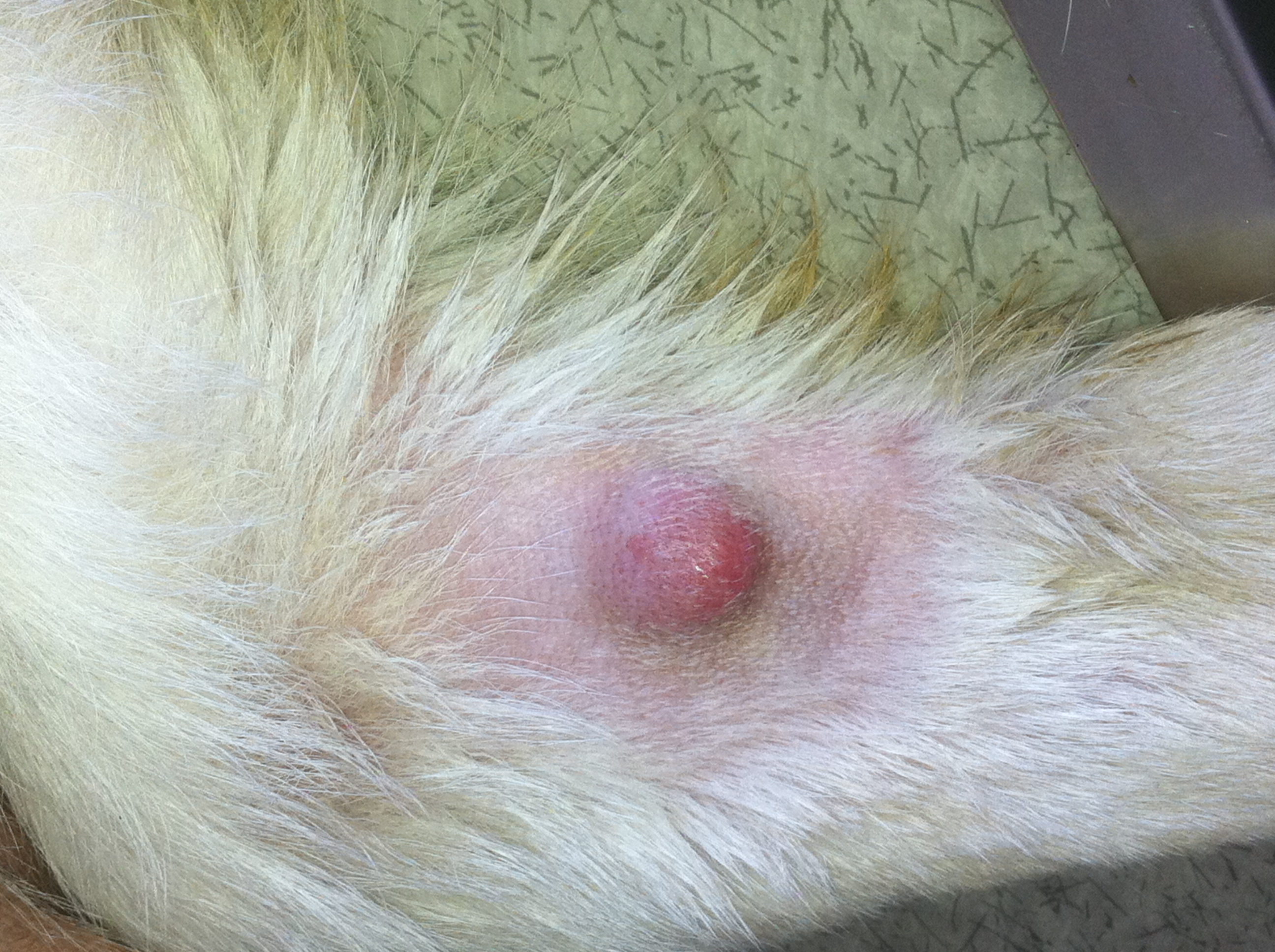Mastocytoma dog
Mastocytoma in dogs is a relatively common skin tumor in dogs with a guarded prognosis.
Although not always malignant, mastocytomas tend to spread and metastasize, colonizing other parts of the animal's body. However, if operated on in time, these tumors have a good chance of survival. It is therefore particularly important to know how to recognize them and to examine your dog regularly to make sure that there are no abnormalities.
Mastocytoma in dogs, what is it?
Mastocytoma is a tumor that develops in the skin and subcutaneous tissue of dogs. It is the most common skin tumor in our four-legged friends. This tumor appears preferentially on middle-aged dogs, although it can affect animals of any age.
It is most often isolated and localized on the trunk, limbs and, more episodically, on the head and neck. However, cases of multiple mastocytomas are also possible, especially in the Boxer and Pug. In fact, certain breeds of dogs are predisposed to the development of mastocytomas. While the Pug is not left out, Boxers and Boston Terriers together account for about 50% of diagnosed cases.
Although mastocytoma is considered a skin tumor, it can also involve visceral tissue, in which case it is more aggressive. The size and appearance of this tumor is variable. The lesion may be a small nodule or a large mass and may become inflamed, bleed, swell or ulcerate.
Not all mastocytomas are malignant, but larger, visceral and/or inflammatory masses are likely to be.
Symptoms of mastocytoma in dogs
Mastocytomas in dogs can range from small nodules rolling under the skin to ulcerated, hairless, swollen and/or bloody masses. When the disease is in an advanced stage, the dog may show signs of general weakness. Vomiting, loss of appetite, blood in the feces, depression or loss of energy may occur.
Depending on the location and size of the tumor, some of the dog's metabolic functions may be impaired. This is particularly the case with visceral mastocytomas, which can compress certain organs and damage them. In general, you should be concerned as soon as you notice any mass on your dog's body, whether it is a small nodule or a larger lump.
Like many diseases, especially tumors, mastocytomas are much better treated when diagnosed early.

Diagnosis and treatment of mastocytoma in dogs
In order to make a definitive diagnosis of a dog's tumor, a few tumor cells must be removed for closer observation under a microscope. A puncture or a biopsy will be performed first, then the tumor will be surgically removed and analyzed in order to determine its grade with more precision.
These valuable indications will help assess the severity of the mastocytoma, including how likely it is to recur and metastasize. Further medical testing can also be used to look for metastases in the dog's body, including prior to surgery.
This alternative can be studied in very old dogs or in case of a very large tumor, in order to decide if an excision, more risky in these conditions, is really indicated and to measure the benefit/risk ratio. In case of malignant mastocytoma, treatment with radiotherapy and/or chemotherapy may be recommended, especially in the case of tumors that could not be completely removed or are not operable at all.
If metastases are present, chemotherapy is often the dog's only option and may, if not cure the animal, alleviate the symptoms of its disease. It should be noted that cancer treatments are more palliative in nature in dogs, and a complete cure is rarely expected.
Prognosis of mastocytoma in dogs
The prognosis of the animal depends greatly on the grade of the mastocytoma when it is managed by a veterinarian. Grades are classification systems to determine the severity of the tumor with respect to its potential for recurrence and metastasis.
Generally, the size of a tumor is indicative of its grade, although it is not the only aspect to consider when classifying a mastocytoma. Grade I and occasionally grade II mastocytomas have a favorable prognosis when successfully removed surgically.
Most grade II and grade III mastocytomas have a poor prognosis, as they have a high potential for local recurrence. It should be noted that some breeds of dogs, Boxers and Carlins, are predisposed to the development of benign forms, which have a favorable prognosis.

What should I do if my dog has a mastocytoma?
First and foremost, remember to examine your dog regularly so that you don't miss a possible mastocytoma, whether it has just appeared or has been lurking in the shadows for a while. By doing a little home checkup once a month, you can reduce the chance of missing a malignant tumor and, if a tumor does occur, offer your dog the earliest possible treatment, which almost always means a better prognosis.
In fact, if you find an abnormal mass under your dog's skin, no matter how large or small, it's important to see a veterinarian to determine if it could be a mastocytoma. Try not to panic, however, as there are other things that can cause small masses to appear on your dog's skin that are not always cancers.
Once the diagnosis is made, it can be a shock, but it is important not to lose hope. Surgery offers good results, and can even completely cure low grade mastocytomas. Don't hesitate to ask your veterinarian if there is any information that is not entirely clear, especially if you have difficulty understanding some of the treatment options available to your dog.
Note that although chemotherapy is generally palliative, it is neither systematically the case nor a reason to turn your back on it on principle. This treatment can not only improve your dog's living conditions during his illness, but also extend his life expectancy.
FAQ
What is a mastocytoma in dogs?
A mastocytoma is a relatively common skin tumor in dogs, which can be benign or malignant. So don't be alarmed when your dog is diagnosed with a mastocytoma after a veterinary visit: this term does not necessarily mean cancer!
How do I know if my dog has a mastocytoma?
Although mastocytoma can take a visceral form, it is more often a skin mass, which can be felt and/or seen by examining your dog thoroughly. However, not every mass that you may find on your dog is a mastocytoma. Veterinary analysis will prove or disprove this hypothesis.
Can mastocytoma be treated in dogs?
Yes, and the first line of treatment is surgical removal. When excision is not possible, either because of its location, size or the dog's health, chemotherapy and/or radiation therapy may be considered. The successful removal of a grade I mastocytoma, or even some grade II tumors, often results in a complete cure without recurrence.
Is mastocytoma in dogs cancerous?
Not all mastocytomas are cancerous, but some may indeed turn out to be malignant, in which case they may spread. Some cancerous mastocytomas, however, can be completely cured with complete surgical removal.
Which dogs are prone to mastocytoma?
Some breeds of dogs are particularly prone to mastocytoma, namely Boxers and Boston Terriers, which together account for half of the canine patients with this disease. The Pug is not far behind them, but fortunately for him, he is more likely to develop a benign form of masticytoma, like the Boxer.
A mastocytoma does not always mean cancer, but it is still important not to overlook the appearance of a small abnormality on your dog's skin so as not to miss a serious form of this disease. Even when they are malignant, these skin tumors can be cured when they are taken care of early. This makes it all the more important to keep a close eye on your dog's health so that you can take action in time if any problems arise.
Taking the time to examine your dog once a month is also an opportunity to establish a small regular ritual to strengthen your bond while taking care of his health. This can be a time for playing and cuddling - no one said it had to be formal!

